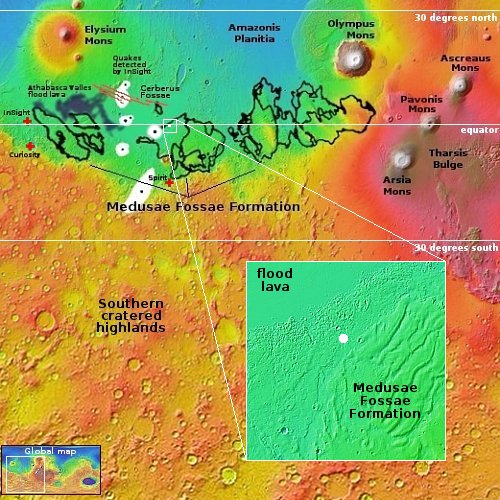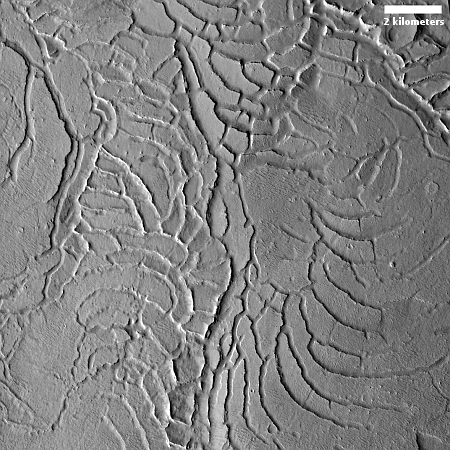Martian waves of ridges and cracks
In preparing today’s cool image I initially planned to post an picture taken on December 26, 2023 by the high resolution camera on Mars Reconnaissance Orbiter (MRO), as it showed a strange series of ridges that almost resembled waves or ripples on a pond.
In digging into MRO’s context camera archive to get the larger context, however, I immediately switched to the photo on the right, cropped, reduced, and sharpened to post here. Taken on December 17, 2010, it shows a much more mysterious and striking set of geological features than the closer view of the high resolution image, with the wave-shaped ridges on its western half but another set of wave-shaped cracks on its eastern half.
Even more intriguing, the arcs for the ridges curve in the opposite direction from the arcs for the cracks. It is almost as if there were two flows moving in opposite directions, right next to each other.

The white dot on the equator on the overview map to the right marks the location. In the inset I indicate the important geology on the surface that might help explain what we are looking at. These curved ridges and cracks are located on the edge of the Medusae Fossae Formation, the largest volcanic ash deposit on Mars.
Thus, we have many geological processes at play here. First, the way volcanic ash will settle over time might explain these curves. Being on the edge of Medusa, the ash might be sagging downhill to form the cracks. Second, the prevailing winds over time might have further reshaped that ash, and might explain the direction of curving arcs. Third, the ash almost certainly sits on top of layers of flood lava, some of which might include flow features (when the lava was molten) that the ash now hints at topographically.
The key word in all this is “might.” These geological processes are all present here, but their importance and contribution to creating these curves is utterly unknown. I am merely guessing.
On Christmas Eve 1968 three Americans became the first humans to visit another world. What they did to celebrate was unexpected and profound, and will be remembered throughout all human history. Genesis: the Story of Apollo 8, Robert Zimmerman's classic history of humanity's first journey to another world, tells that story, and it is now available as both an ebook and an audiobook, both with a foreword by Valerie Anders and a new introduction by Robert Zimmerman.
The print edition can be purchased at Amazon or from any other book seller. If you want an autographed copy the price is $60 for the hardback and $45 for the paperback, plus $8 shipping for each. Go here for purchasing details. The ebook is available everywhere for $5.99 (before discount) at amazon, or direct from my ebook publisher, ebookit. If you buy it from ebookit you don't support the big tech companies and the author gets a bigger cut much sooner.
The audiobook is also available at all these vendors, and is also free with a 30-day trial membership to Audible.
"Not simply about one mission, [Genesis] is also the history of America's quest for the moon... Zimmerman has done a masterful job of tying disparate events together into a solid account of one of America's greatest human triumphs."--San Antonio Express-News
In preparing today’s cool image I initially planned to post an picture taken on December 26, 2023 by the high resolution camera on Mars Reconnaissance Orbiter (MRO), as it showed a strange series of ridges that almost resembled waves or ripples on a pond.
In digging into MRO’s context camera archive to get the larger context, however, I immediately switched to the photo on the right, cropped, reduced, and sharpened to post here. Taken on December 17, 2010, it shows a much more mysterious and striking set of geological features than the closer view of the high resolution image, with the wave-shaped ridges on its western half but another set of wave-shaped cracks on its eastern half.
Even more intriguing, the arcs for the ridges curve in the opposite direction from the arcs for the cracks. It is almost as if there were two flows moving in opposite directions, right next to each other.

The white dot on the equator on the overview map to the right marks the location. In the inset I indicate the important geology on the surface that might help explain what we are looking at. These curved ridges and cracks are located on the edge of the Medusae Fossae Formation, the largest volcanic ash deposit on Mars.
Thus, we have many geological processes at play here. First, the way volcanic ash will settle over time might explain these curves. Being on the edge of Medusa, the ash might be sagging downhill to form the cracks. Second, the prevailing winds over time might have further reshaped that ash, and might explain the direction of curving arcs. Third, the ash almost certainly sits on top of layers of flood lava, some of which might include flow features (when the lava was molten) that the ash now hints at topographically.
The key word in all this is “might.” These geological processes are all present here, but their importance and contribution to creating these curves is utterly unknown. I am merely guessing.
On Christmas Eve 1968 three Americans became the first humans to visit another world. What they did to celebrate was unexpected and profound, and will be remembered throughout all human history. Genesis: the Story of Apollo 8, Robert Zimmerman's classic history of humanity's first journey to another world, tells that story, and it is now available as both an ebook and an audiobook, both with a foreword by Valerie Anders and a new introduction by Robert Zimmerman.
The print edition can be purchased at Amazon or from any other book seller. If you want an autographed copy the price is $60 for the hardback and $45 for the paperback, plus $8 shipping for each. Go here for purchasing details. The ebook is available everywhere for $5.99 (before discount) at amazon, or direct from my ebook publisher, ebookit. If you buy it from ebookit you don't support the big tech companies and the author gets a bigger cut much sooner.
The audiobook is also available at all these vendors, and is also free with a 30-day trial membership to Audible.
"Not simply about one mission, [Genesis] is also the history of America's quest for the moon... Zimmerman has done a masterful job of tying disparate events together into a solid account of one of America's greatest human triumphs."--San Antonio Express-News


